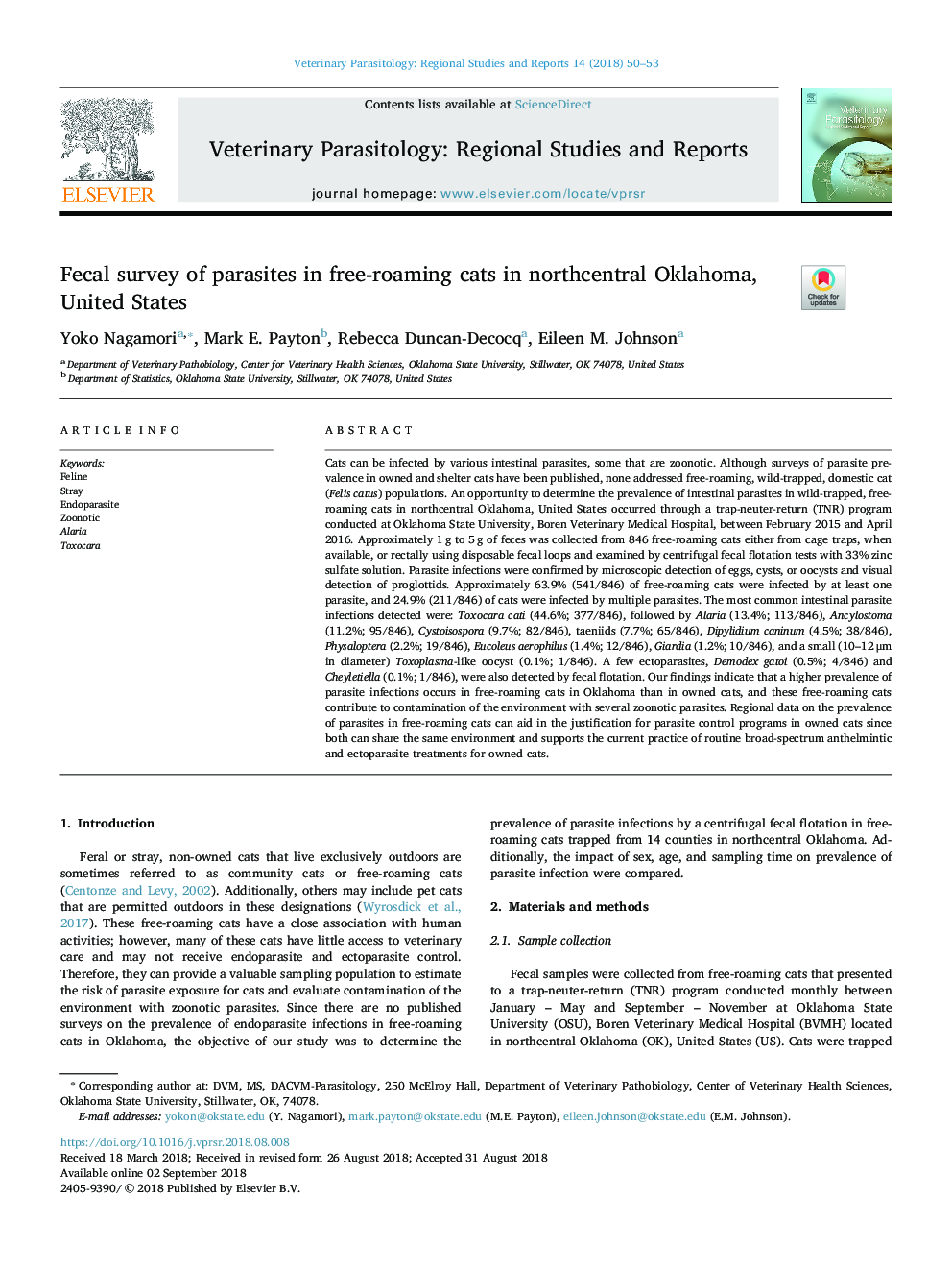| کد مقاله | کد نشریه | سال انتشار | مقاله انگلیسی | نسخه تمام متن |
|---|---|---|---|---|
| 9954703 | 1555860 | 2018 | 4 صفحه PDF | دانلود رایگان |
عنوان انگلیسی مقاله ISI
Fecal survey of parasites in free-roaming cats in northcentral Oklahoma, United States
ترجمه فارسی عنوان
بررسی فشاری انگل ها در گربه های رایگان رومینگ در شمال مرکزی اوکلاهما، ایالات متحده
دانلود مقاله + سفارش ترجمه
دانلود مقاله ISI انگلیسی
رایگان برای ایرانیان
موضوعات مرتبط
علوم پزشکی و سلامت
علوم و ابزار دامپزشکی
علوم دامپزشکی
چکیده انگلیسی
Cats can be infected by various intestinal parasites, some that are zoonotic. Although surveys of parasite prevalence in owned and shelter cats have been published, none addressed free-roaming, wild-trapped, domestic cat (Felis catus) populations. An opportunity to determine the prevalence of intestinal parasites in wild-trapped, free-roaming cats in northcentral Oklahoma, United States occurred through a trap-neuter-return (TNR) program conducted at Oklahoma State University, Boren Veterinary Medical Hospital, between February 2015 and April 2016. Approximately 1â¯g to 5â¯g of feces was collected from 846 free-roaming cats either from cage traps, when available, or rectally using disposable fecal loops and examined by centrifugal fecal flotation tests with 33% zinc sulfate solution. Parasite infections were confirmed by microscopic detection of eggs, cysts, or oocysts and visual detection of proglottids. Approximately 63.9% (541/846) of free-roaming cats were infected by at least one parasite, and 24.9% (211/846) of cats were infected by multiple parasites. The most common intestinal parasite infections detected were: Toxocara cati (44.6%; 377/846), followed by Alaria (13.4%; 113/846), Ancylostoma (11.2%; 95/846), Cystoisospora (9.7%; 82/846), taeniids (7.7%; 65/846), Dipylidium caninum (4.5%; 38/846), Physaloptera (2.2%; 19/846), Eucoleus aerophilus (1.4%; 12/846), Giardia (1.2%; 10/846), and a small (10-12â¯Î¼m in diameter) Toxoplasma-like oocyst (0.1%; 1/846). A few ectoparasites, Demodex gatoi (0.5%; 4/846) and Cheyletiella (0.1%; 1/846), were also detected by fecal flotation. Our findings indicate that a higher prevalence of parasite infections occurs in free-roaming cats in Oklahoma than in owned cats, and these free-roaming cats contribute to contamination of the environment with several zoonotic parasites. Regional data on the prevalence of parasites in free-roaming cats can aid in the justification for parasite control programs in owned cats since both can share the same environment and supports the current practice of routine broad-spectrum anthelmintic and ectoparasite treatments for owned cats.
ناشر
Database: Elsevier - ScienceDirect (ساینس دایرکت)
Journal: Veterinary Parasitology: Regional Studies and Reports - Volume 14, December 2018, Pages 50-53
Journal: Veterinary Parasitology: Regional Studies and Reports - Volume 14, December 2018, Pages 50-53
نویسندگان
Yoko Nagamori, Mark E. Payton, Rebecca Duncan-Decocq, Eileen M. Johnson,
